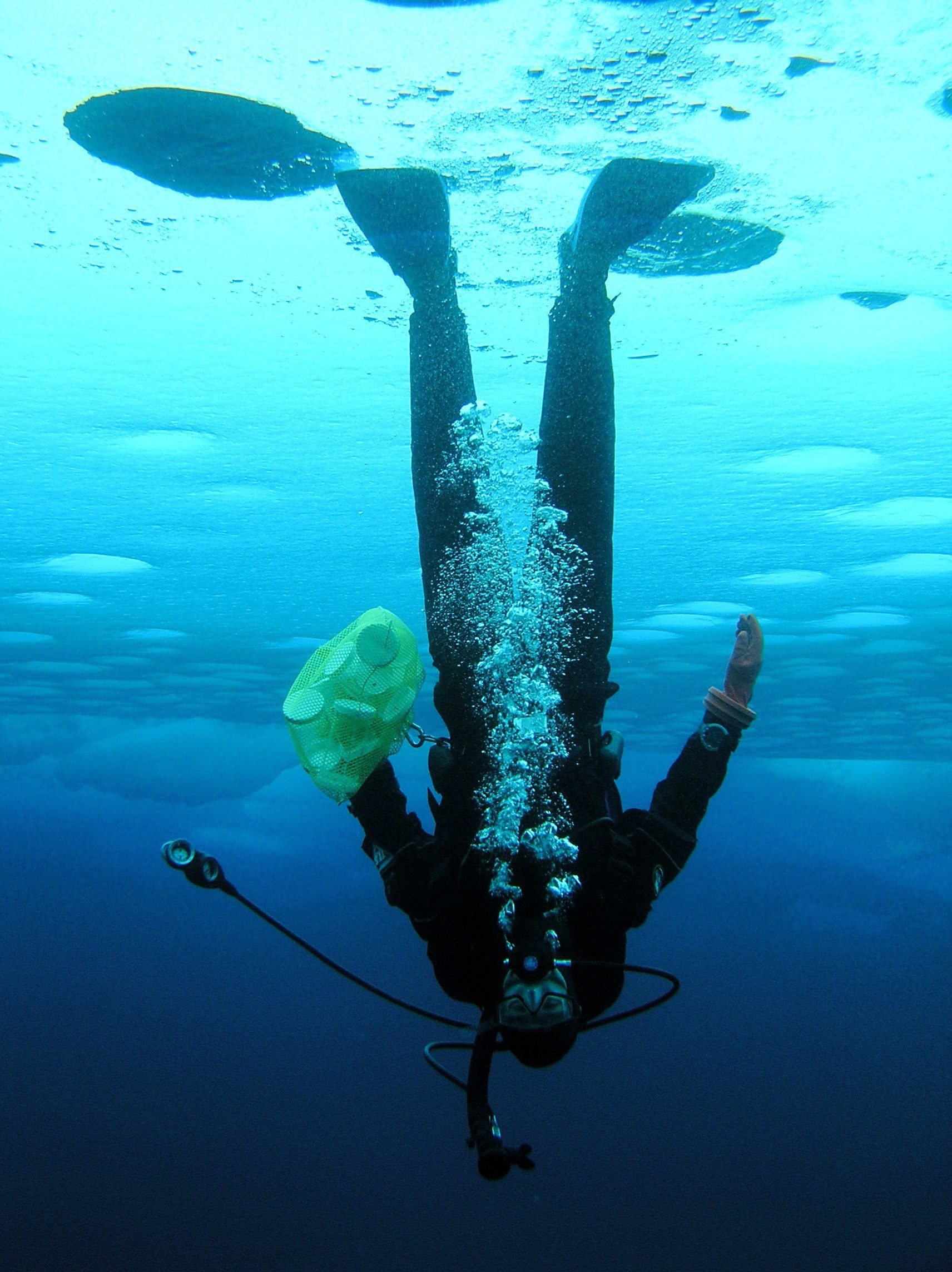Russian Team Sets New World Record for Deepest Ice Dive
It’s a sport that is as terrifying as it is poetic.

Ice diver Shawn Harper stands on the ice ceiling separating him from the safety of dry land (Photo: Hidden Ocean Expedition 2005/NOAA/OAR/OER/CC-BY-2.0).
This weekend, two Russian explorers, Maxim Astakhov and Alexander Gubin, have set a new world record for deepest ice dive as part of their work with the Russian Geographical Society. The two men descended 102 meters (335 feet) during an 80-minute dive in the White Sea, just outside the Arctic Circle, as part of the Russian Geographical Society’s 13 Seas of Russia project.
It’s a huge achievement, not least because ice diving takes all the challenges of deep sea diving and adds a few more for good measure.
As University of Alaska Assistant Professor and scientific diver Katrin Iken explains for NOAA, ice diving is very similar to regular diving, but there are a few crucial differences. Divers must cope with extremely cold underwater temperatures—for instance, during Astakhov and Gubin’s dive yesterday, water temperature was a chilly -1.5C (29F). Therefore, ice divers wear drysuits instead of wetsuits, sealing them to prevent water from getting inside the suit. Underneath the drysuit, divers wear thick polypropylene underwear for warmth. A thick neoprene hood and gloves protect their head and hands, but there’s still some cold exposure as divers trade thick material for better dexterity.
The biggest—and most terrifying—difference between ice diving and other dives involves access to the surface (and wonderful, necessary things like air and solid ground). Sea ice can be several meters thick, and divers’ only way past the ice is the human-sized entry and exit hole carved by the dive team. This creates a few problems.
First, maintaining orientation underwater can be tricky—at deep depths, it can be hard to tell up from down. According to Iken, maintaining orientation is fairly easy in regular diving, because the diver can just float to the surface, re-orient, and dive back down (or swim back to the boat). In ice diving, divers are trapped beneath a thick ice ceiling and simply popping up to the surface is impossible. To keep divers safe, they are tethered to the surface, and communicate with the dive team via a code of short pulls. Elizabeth Calvert, another experienced ice diver, explains the code to NOAA:
Line signals are our only form of communication from under the ice to the surface. One pull means “o.k.” Two pulls means “give me more slack in the line.” Three pulls means “take up slack in the line.” And a lot of pulls means “pull me out!”
Another additional risk when ice diving involves the equipment that keeps divers supplied with oxygen. Diving regulators, which depressurize the air in a diver’s oxygen tank, can freeze and malfunction. Testing that equipment is suited for the harsh conditions of ice diving is one of the purposes of the 13 Seas of Russia project and yesterday’s dive.
Despite the potential for extreme claustrophobia, ice divers unanimously celebrate the awesome beauty of the underwater world beneath the ice. Rob Robbins, Supervisor of Dive Services at Antarctica’s McMurdo Station, explains that ice divers experience unprecedented underwater visibility—up to 800 feet, whereas visibility is places like the Caribbean tops out at about 150 feet—in an interview on Polar Field Services’ blog. “Under the water it is lush,” says Robbins. “There’s an enormous variety of sponges and it is so colorful. The invertebrate life is amazing and so is the visibility. There is no where [sic] else in the world where you can jump in the water and see the underwater terrain like you can in Antarctica.”
Astakhov and Gubin echoed the sentiment yesterday, according to The Guardian, “It was a joy to see the living creatures that exist at the depth of 102 metres, practically on the bottom of the White Sea,” Astakhov said. The team plans to continue making record-setting ice dives, with the goal of exploring each sea in Russia.
Footage of yesterday’s record-setting dive (Video: Ruptly TV).







Follow us on Twitter to get the latest on the world's hidden wonders.
Like us on Facebook to get the latest on the world's hidden wonders.
Follow us on Twitter Like us on Facebook